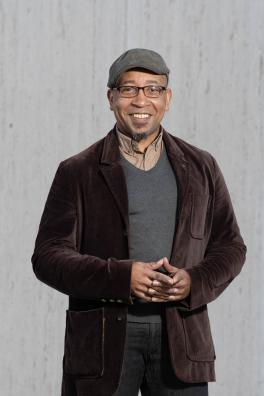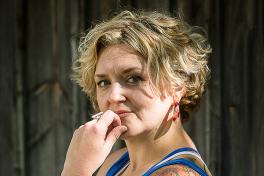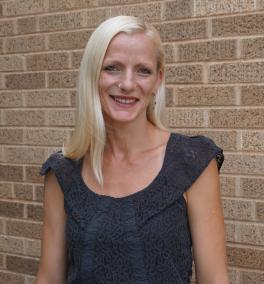Ohio State Dance is thriving and celebrating the arrival of three new faculty this autumn. We caught up with them after classes started this fall to chat about their research/creative inquiry, why they made the move to Ohio State, and their vision for the department.

Professor Charles O. Anderson joined the department faculty as chair on June 1, 2022. Anderson is artistic director of Charles O. Anderson/dance theatre X, an afro-contemporary dance theatre company, which he founded in Philadelphia in 2003. Born and raised in Richmond, VA, Charles earned his BA in Choreography and Performance from Cornell University and his MFA in Dance from Temple University. He has performed in the companies of Ronald K. Brown, Sean Curran, Mark Dendy and Miguel Gutierrez among others. His work has been presented nationally and internationally and has earned recognition by numerous grants and organizations such as the Pew Fellowship in the Arts, one of “25 to Watch” by Dance Magazine, and one of “12 Rising Stars in the Academy” by Diverse: Issues In Higher Education Magazine. Previously, Anderson was head of the dance program and Professor of African Diaspora Dance at The University of Texas at Austin. Anderson also was also president of the Council of Dance Administrators (CODA) and served on faculty of the American Dance Festival six-week school in Durham, NC.
Ohio State Dance: The mission of your dance theatre company Charles O. Anderson dance theatre X is “to examine, promote, and enact liberatory aesthetic practices that provide space for social reflection, commentary and critique in service to social justice.” How does this creative inquiry inspire, inform and influence your work as a professor and as an administrator?
Anderson: I have been fortunate to pursue a broad and interdisciplinary career as a choreographer, educator and administrative thought-leader gaining experience as first a junior high school vice principal for at-risk youth in East Harlem, then a faculty member at a private liberal arts college, and now chair of a Tier 1 research institution. For a number of years now, I have been conducting scholarly and movement research as well as exploration of curricular design to further explore the impact(s) of political, economic and cultural convergences on non-western movement traditions by training and collaborating with international artists and immersing myself in the current literature on race, power and representation. Through this research I have developed a body of artistic work and administrative strategies that reflect who I am (a southern born gay American of African descent who is a first-generation college graduate, an artist, intellectual and activist) and what I value (artistic and scholarly production that invested in liberatory practices with the goal of advocating for social change and promoting social justice).
As an educator, my job is to educate, not indoctrinate, to help students develop their critical thinking skills. Though my pedagogical and administrative strategies vary dependent on the context, my overarching goals remain consistent:
- To instill in students the motivation to become invested in their own education and learning process;
- To continually rediscover the value of embodied forms of knowledge and to develop as intellectually curious people;
- To recognize that knowledge is informed by culture and that what we do with our knowledge informs culture;
- And finally, to nourish an agile and open mind/body/spirit that strives to make multiple connections across disciplines and cultural contexts and to integrate these bodies knowledge into their own artistic practices.
Through a focus on praxis, or the symbiotic relationship between theory and practice, I come to Ohio State prepared to further the work of making liberatory theory accessible and relevant to students who create and teach across the arts. The goal is for the communities of which I am a part to become what bell hooks refers to as radically open—or awake to the possibility of being changed by encountering new people, ideas and experiences.
Defined by a varied and dynamic blend of physical practice and embodied theory, I hope our program will become even more obviously the place to:
- Deepen and broaden physical training (in multiple concert dance forms and commercial idioms), while cultivating a critical engagement with these forms;
- Develop choreographic skills, explore experimental technologies, in service to becoming sophisticated, nuanced artists;
- Cultivate an understanding between performance and culturally inclusive and critically rigorous pedagogy;
- Expand our understanding of the art and practice of performance (via formal and informal performances, in-progress showings, scholarly lectures etc.);
- Become an arts activist, arts educator and arts advocate- Artist Citizens;
- Grow in scholarship and sophistication in culture and the arts in general.
From this standpoint, in collaboration with my faculty colleagues, I hope to carry on the work already begun by my amazing predecessors- to continue expanding and deepening the scope and sequence of our curriculum to simultaneously provide stellar physical, creative, scholarly and pedagogical training committed to examining power and privilege, and to emphasizing pluralistic opportunities for students to grow their knowledge and skills in service to community partnership and engagement.
Ohio State Dance: As a self-described artist-educator, an intellectual and a kinetic storyteller, what kind of dance theatre are you moved to create?
Anderson: I weave what to some might appear to be disparate modes of expression- gleaned from successive eras in my professional training and personal life- into multi-layered yet always culturally inclusive dance work (as well as curricular and organizational models). I think my work both in academia and for the concert stage reveals that I am a diasporic artist who approaches choreography and arts education as metaphor for testimony. Testimony is the declaration of truth integral to the Diasporic African oral and literary tradition, going back to the slave narrative and folk practices (and beyond). Testimonies can give praise and they can boast. They can also attest to suffering and injustice, but their goal is always to move the audience. It is a form of storytelling based on the personal truth(s) of the teller(s). It is used to allow the storyteller to connect with those who hear the testimony, as well as to a higher plane of being. As a result, the underlying premises that have and continue to inform my work deal with the idea of the arts as tools for spiritual renewal, community building and cultural re-imagination. My body of artistic work, or in other words-my scholarship- is connected to my pedagogy and administrative practice. Writer, organizational healer and pleasure activist adrienne maree brown writes about the power of imagination—specifically our (collective) imagination—to create freedom and fear, life and death; to will thoughts into action and manifest realities. By thinking through imagination as the possibility and opportunity to extinguish identity-based oppression, brown urges us into knowing that our radical imagination is in fact a tool “for reclaiming our right to shape our[own] lived reality.” As an artist, educator and administrator I reckon with the ways that images and words become truths, truths that get re-made, reinforced and recycled on stages, onscreen, in classrooms and in our streets. brown’s theories on radical imagination and decolonization offer ways of seeing, creating and performing that enact a more just and equitable world. I call myself a kinetic storyteller because I strive to center the radical imagination, challenging audiences, students and faculty colleagues to use their resources as tools for visioning, creating, disrupting and connecting.
Ohio State Dance: What are the best things about the Ohio State art scene right now?
Anderson: As I have mentioned to almost anyone willing to listen, I am genuinely thrilled by the progressive approach to wholistic training I am witnessing in the Department of Dance. I am particularly impressed by the work initiated by our graduate students around anti-racist strategies in our approach to dance and the arts. This is coupled by my awe at the university’s commitment to uplift the arts in its strategic vision for 21st education. I believe in the power of the arts to transform humanity and to make the world a more equitable place. Once again, adrienne maree brown’s words echo in my ears: We are in an imagination battle. Our imagination gives birth to images, words and actions—each an individual prayer—calling in a future, a future that requires researched intentions and meaningful action. The future is now and we need to be the change we seek. I look forward to working with all of you to ensure that the Department of Dance continues to be a leader in higher education as we train the next generation of artists, activists, scholars, educators, makers and creatives ready to change the world.

2012 MFA Dance Alumna Abby Zbikowski joined the Department of Dance faculty in autumn 2022 as an associate professor. Zbikowski, who was awarded the prestigious 2020 United States Artist Fellowship, is teaching contemporary movement practice and choreographing a new work for the upcoming Faculty Concert, November 3 – 5, 2022.
Abby Zbikowski created her company Abby Z and the New Utility in 2012 with founding members and MFA Dance Alumnae Fiona Lundie (2012) and Jennifer Meckley (2013). She received the 2017 Juried Bessie Award for her “unique and utterly authentic movement vocabulary in complex and demanding structures to create works of great energy, intensity, surprise, and danger” and was awarded a “Choreographer of the Future” commission by Dance Umbrella UK in 2018. She was an inaugural Caroline Hearst Choreographer-In-Residence at the Lewis Center of the Arts at Princeton University (2017-19), artist in residence at New York Live Arts (2018-20), and has also been in residence at Bates Dance Festival, American Dance Festival, and the STREB Lab for Action Mechanics.
Before joining the faculty at Ohio State Dance, she served as an associate professor of dance at the University of Illinois and on faculty at American Dance Festival. She has taught at the Academy of Culture in Riga, Latvia; at Festival Un Pas Vers L’Avant in Abidjan, Ivory Coast; and studied at Germaine Acogny’s L’École de Sables in Senegal. Zbikowski holds a BFA in dance from Temple University and an MFA in dance from The Ohio State University.
Zbikowski has performed with Charles O. Anderson/dance theater X, Momar Ndiaye, and the Baker & Tarpaga Dance Project. Her company has been presented nationally, performing at venues such as Jacob’s Pillow in Becket, MA, and the Fuse Box Festival in Austin, TX, among others. Her company’s new work Radioactive Practice premiered at New York Live Arts in New York City on May 18, 2022.
Ohio State Dance: Congratulations on the premiere of Radioactive Practice last May in New York and the recent New York Times article about your work by Dance Writer Gia Kourlas. Radioactive Practice will be performed at the Wexner Center November 17-19, 2022 at 8 pm. Will you please tell future audiences about this work and how it came to be?
Zbikowski: This work has had many lives over the last four years, originally being slated to premiere in March 2020, right as NYC was going into lockdown. Over the last year, in its final stages of development, I think that it finally found what it was meant to be all along which is unabashedly itself. Owning its stripped-down exposure of the human psyche in a world that is in such rapid transition and information overload that it struggles to see the nuance of what we all are actually attempting to communicate to each other. That evolution happened while in residence at the Wexner Center last fall and we will be back performing the work there November 17-19, 2022.
Ohio State Dance: You created Abby Z and the New Utility in 2012 with dancers Fiona Lundie and Jennifer Meckley “to experiment with the potential and choreographic possibility of the body being pushed beyond perceived limits, creating a new movement lexicon that triangulates dancing/moving bodies across multiple cultural value systems simultaneously.” How does this work translate to your students in the studio and classroom?
Zbikowski: Perceived limits are a moving target, vary from person to person, and aren't created in a vacuum. They are culturally constructed. I invite students to understand the deeply layered histories that live inside them, as well as the people who have taught them. And these histories go far beyond dance lineages. Our outlooks on the world, how we see ourselves, and what we think dance can and cannot do are all interrelated. In composition classes and while making new work I encourage students to pull these stands apart to examine how they got there and if they are serving them. In my technique classes we prepare head on for the ways in which the confluence of cultural information bombard us on a daily basis in our contemporary realities.
Ohio State Dance: Will you please tell us a little about the new work you are making for the upcoming Department of Dance Faculty Concert, to be performed November 3-5, 2022 in the Barnett Theatre?
Zbikowski: I'm making a new work for this show with 9 dancers called "Cannonball". It's about the tipping point for people between passivity and action in the body and in life. What does it take to embrace difficult issues, panic inducing issues, like the global water crisis. How do we work through discomfort and anxiety, which can have paralyzing effects, to discover what we're really made of.

Tanya Calamoneri, PhD, joined the dance faculty as an assistant professor. She is a dancer, choreographer, dance researcher and dance cultural studies scholar. Her research focuses on somatics and butoh dance, a post-WWII Japanese performance form that uses imagery as its impetus and methodology for creating environment, state and movement. She also writes about issues concerning the migration of forms across cultural boundaries in a globalized world.
Her research is published in Routledge's Theatre, Dance and Performance Training Journal, Dance Chronicle, Journal of Dance Education and a chapter in the Routledge Butoh Companion as well as a chapter in the Routledge Intercultural Actor and Performer Training. She recently published a book on butoh in the United States and Mexico, titled Butoh America.
Her New York-based company, Company SoGoNo, was funded by NYSCA, NYFA, AMC Live Music for Dance, and recognized by New York Innovative Theatre Awards. Previously she worked as an arts administrator; in San Francisco, she was Executive Director of Dancers' Group, and in New York, Co-Executive Director of The Field, and at Brooklyn Academy of Music as Project Manager of the State Department's cultural diplomacy program, DanceMotion USA.
Ohio State Dance: How does your research on somatics and butoh dance influence your work in the classroom and studio?
Calamoneri: What I draw from somatics is the notion that we are all the authority on our own bodies and also that there are multiple inroads to tuning in to own’s own internal experience. From butoh dance I draw the methodology of images to inform movement practice, and I use these tools in my creative practice and my approach to teaching contemporary dance. One student may respond to the cue to lengthen their cervical spine in order to complete a diving roll, while another may understand the physics of the movement better when I direct them not to be a scared turtle. I use anatomical and metaphor images to communicate alignment and the proper degree of tension to execute movements.
Ohio State Dance: What excites you about the future of health and wellness in the Department of Dance?
Calamoneri: There are so many resources! Students have unparalleled access to health professionals that understand our craft and the unique needs of dancers. There are also so many people willing to collaborate on projects that will benefit our students. By this time next year I hope to have a few research projects off the ground, so please stay tuned!
Ohio State Dance: Will you please tell us a little about the new work you are making for the upcoming Department of Dance Faculty Concert, to be performed November 3-5, 2022 in the Barnett Theatre?
Calamoneri: We are dancing with lots of plastic bottles and trash bags! I am working with the dancers to develop movement that expresses struggles of access to clean water, dealing with human garbage, and the ironic beauty of the light catching a floating bottle or the wind capturing a plastic bag.
